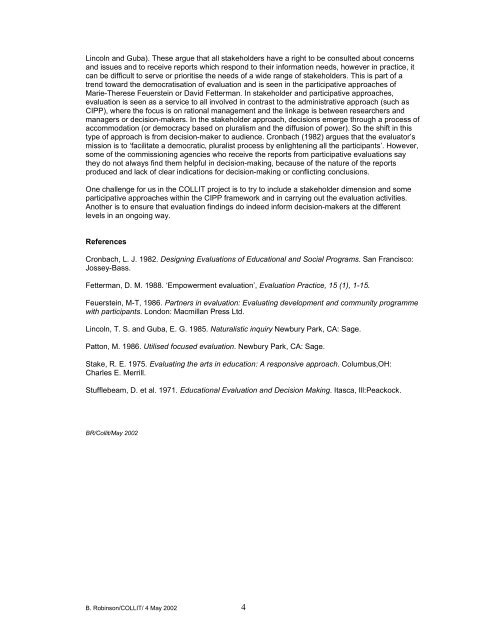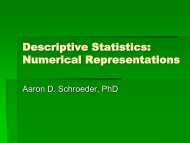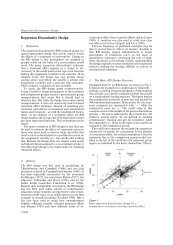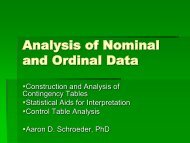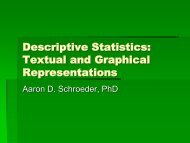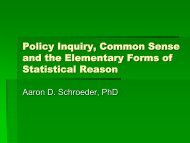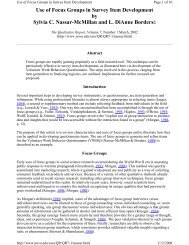The CIPP approach to evaluation
The CIPP approach to evaluation
The CIPP approach to evaluation
Create successful ePaper yourself
Turn your PDF publications into a flip-book with our unique Google optimized e-Paper software.
Lincoln and Guba). <strong>The</strong>se argue that all stakeholders have a right <strong>to</strong> be consulted about concerns<br />
and issues and <strong>to</strong> receive reports which respond <strong>to</strong> their information needs, however in practice, it<br />
can be difficult <strong>to</strong> serve or prioritise the needs of a wide range of stakeholders. This is part of a<br />
trend <strong>to</strong>ward the democratisation of <strong>evaluation</strong> and is seen in the participative <strong>approach</strong>es of<br />
Marie-<strong>The</strong>rese Feuerstein or David Fetterman. In stakeholder and participative <strong>approach</strong>es,<br />
<strong>evaluation</strong> is seen as a service <strong>to</strong> all involved in contrast <strong>to</strong> the administrative <strong>approach</strong> (such as<br />
<strong>CIPP</strong>), where the focus is on rational management and the linkage is between researchers and<br />
managers or decision-makers. In the stakeholder <strong>approach</strong>, decisions emerge through a process of<br />
accommodation (or democracy based on pluralism and the diffusion of power). So the shift in this<br />
type of <strong>approach</strong> is from decision-maker <strong>to</strong> audience. Cronbach (1982) argues that the evalua<strong>to</strong>r’s<br />
mission is <strong>to</strong> ‘facilitate a democratic, pluralist process by enlightening all the participants’. However,<br />
some of the commissioning agencies who receive the reports from participative <strong>evaluation</strong>s say<br />
they do not always find them helpful in decision-making, because of the nature of the reports<br />
produced and lack of clear indications for decision-making or conflicting conclusions.<br />
One challenge for us in the COLLIT project is <strong>to</strong> try <strong>to</strong> include a stakeholder dimension and some<br />
participative <strong>approach</strong>es within the <strong>CIPP</strong> framework and in carrying out the <strong>evaluation</strong> activities.<br />
Another is <strong>to</strong> ensure that <strong>evaluation</strong> findings do indeed inform decision-makers at the different<br />
levels in an ongoing way.<br />
References<br />
Cronbach, L. J. 1982. Designing Evaluations of Educational and Social Programs. San Francisco:<br />
Jossey-Bass.<br />
Fetterman, D. M. 1988. ‘Empowerment <strong>evaluation</strong>’, Evaluation Practice, 15 (1), 1-15.<br />
Feuerstein, M-T, 1986. Partners in <strong>evaluation</strong>: Evaluating development and community programme<br />
with participants. London: Macmillan Press Ltd.<br />
Lincoln, T. S. and Guba, E. G. 1985. Naturalistic inquiry Newbury Park, CA: Sage.<br />
Pat<strong>to</strong>n, M. 1986. Utilised focused <strong>evaluation</strong>. Newbury Park, CA: Sage.<br />
Stake, R. E. 1975. Evaluating the arts in education: A responsive <strong>approach</strong>. Columbus,OH:<br />
Charles E. Merrill.<br />
Stufflebeam, D. et al. 1971. Educational Evaluation and Decision Making. Itasca, Ill:Peackock.<br />
BR/Collit/May 2002<br />
B. Robinson/COLLIT/ 4 May 2002 4


